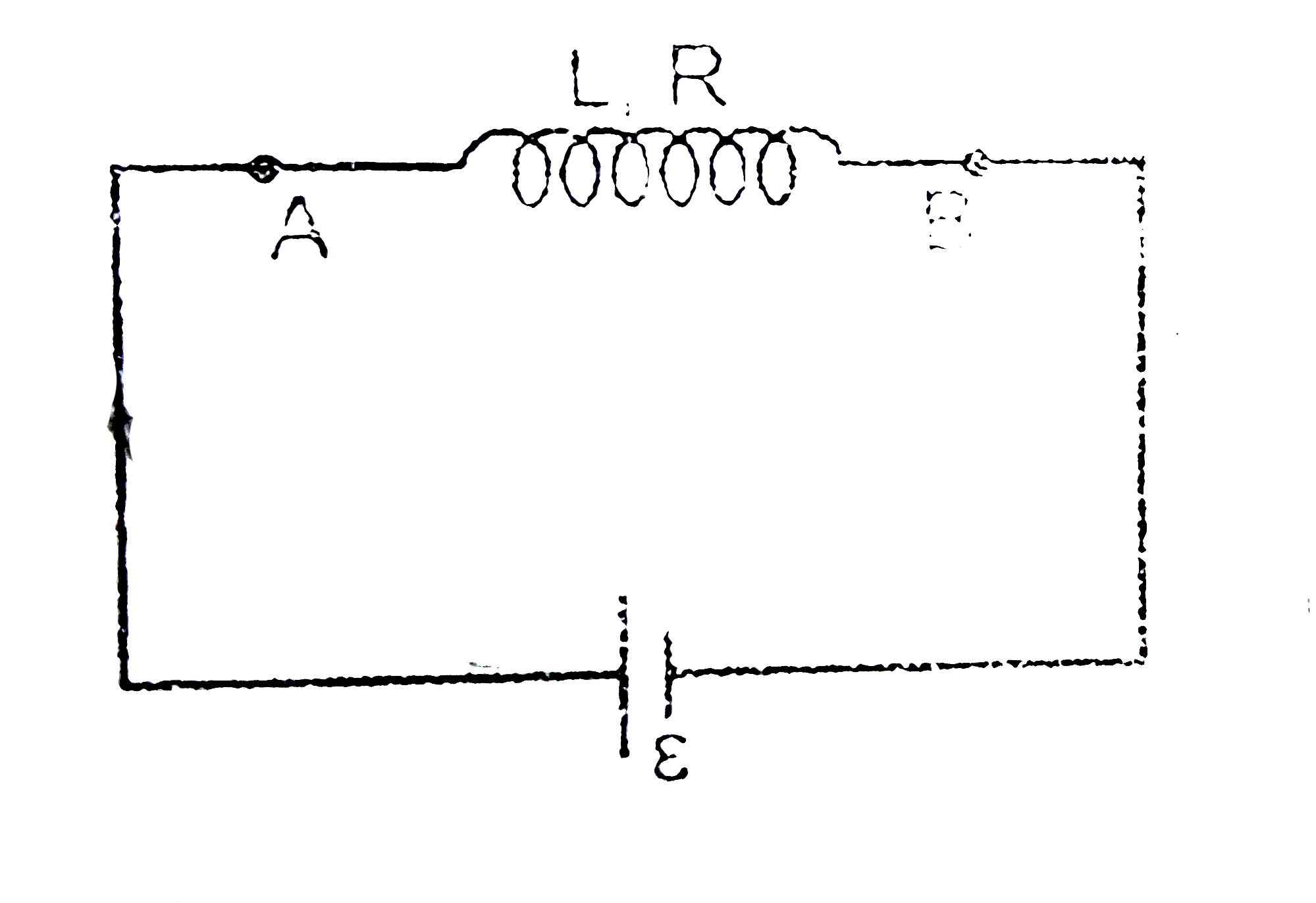An LR circuit has L = 1.0 H R=20Ω. It is connected across an emf of 2.0V at t=0. Find didt at (a) t =100ms, (b) t =200 ms and (c ) t = 1.0 s.
To solve the problem step by step, we will use the concepts of an LR circuit and the formulas related to current and its rate of change.
Given Data:
- Inductance, L=1.0H
- Resistance, R=20Ω
- EMF, E=2.0V
Step 1: Find I0 and τ
1. Calculate I0:
I0=ER=2.0V20Ω=0.1A
2. Calculate τ (time constant):
τ=LR=1.0H20Ω=0.05s
Step 2: Derive the formula for didt
The current I(t) in an LR circuit is given by:
I(t)=I0(1−e−tτ)
To find didt, we differentiate I(t):
didt=ddt(I0(1−e−tτ))
Using the chain rule:
didt=I0⋅(0−(−1τe−tτ))=I0τe−tτ
Substituting I0 and τ:
didt=0.10.05e−t0.05=2e−t0.05
Step 3: Calculate didt for different times
(a) For t=100ms=0.1s
didt=2e−0.10.05=2e−2
Calculating e−2:
e−2≈0.1353
Thus,
didt≈2×0.1353≈0.2706A/s
(b) For t=200ms=0.2s
didt=2e−0.20.05=2e−4
Calculating e−4:
e−4≈0.0183
Thus,
didt≈2×0.0183≈0.0366A/s
(c) For t=1.0s
didt=2e−1.00.05=2e−20
Calculating e−20:
e−20≈1.39×10−9
Thus,
didt≈2×1.39×10−9≈2.78×10−9A/s
Final Answers:
- (a) didt≈0.27A/s
- (b) didt≈0.037A/s
- (c) didt≈4×10−9A/s
- Inductance, L=1.0H
- Resistance, R=20Ω
- EMF, E=2.0V
1. Calculate I0:
I0=ER=2.0V20Ω=0.1A
τ=LR=1.0H20Ω=0.05s
The current I(t) in an LR circuit is given by:
I(t)=I0(1−e−tτ)
To find didt, we differentiate I(t):
didt=ddt(I0(1−e−tτ))
Using the chain rule:
didt=I0⋅(0−(−1τe−tτ))=I0τe−tτ
Substituting I0 and τ:
didt=0.10.05e−t0.05=2e−t0.05
didt=2e−0.10.05=2e−2
Calculating e−2:
e−2≈0.1353
Thus,
didt≈2×0.1353≈0.2706A/s
didt=2e−0.20.05=2e−4
Calculating e−4:
e−4≈0.0183
Thus,
didt≈2×0.0183≈0.0366A/s
didt=2e−1.00.05=2e−20
Calculating e−20:
e−20≈1.39×10−9
Thus,
didt≈2×1.39×10−9≈2.78×10−9A/s
- (a) didt≈0.27A/s
- (b) didt≈0.037A/s
- (c) didt≈4×10−9A/s
Topper's Solved these Questions
- BOOK - HC VERMA ENGLISHCHAPTER - ELECTROMAGNETIC INDUCTIONEXERCISE - Questions for short answer9videos
ELECTROMAGNETIC INDUCTION
- BOOK - HC VERMA ENGLISHCHAPTER - ELECTROMAGNETIC INDUCTIONEXERCISE - Objective 210videos
ELECTROMAGNETIC INDUCTION
- BOOK - HC VERMA ENGLISHCHAPTER - ELECTRIC FIELD AND POTENTIALEXERCISE - Objective 27videos
ELECTRIC FIELD AND POTENTIAL
- BOOK - HC VERMA ENGLISHCHAPTER - ELECTROMAGNETIC WAVESEXERCISE - Exercise8videos
ELECTROMAGNETIC WAVES
Similar Questions
An LR circuit has L= 1.0 H and R=20Ω. It is connected across an emf of 2.0 V at t=0. Find di/dt and Ldi/dt at t=50ms.
View SolutionAn LR series circuit has L=1H and R=1Ω.It is connected across an emf of 2V.The maximum rate at which energy is stored in the magnetic field is:
 View Solution
View SolutionAn inductor-coil of inductance 20 mH having resistance 10Ω is joined to an ideal battery of emf 5.0 V. Find the rate of change of the induced emf at t=0, (b) t = 10 ms and (c ) t = 1.0s.
View SolutionAn inductor-coil of inductance 20 mH having resistance 10Ω is joined to an ideal battery of emf 5.0 V. Find the rate of change of the induced emf at t=0, (b) t = 10 ms and (c ) t = 1.0s.
View SolutionThe time constant of an LR circuit is 40 ms. The circuit is connected at t= 0 and the steady state current is found ot be 2.0 A. Find the current at (a) t= 10 ms (b) t =20ms, (c ) t =100ms and (d) t = 1 s.
View SolutionAn LCR series circuit with L=100mH,C=100μF,R=120Ω is connected to an AC source of emfε=(30V)sin(100s−1)t. Find the impedane, the peak current and the resonant frequency of the circuit.
View SolutionAn LR circuit constains an inductor of 500 mH, a resistor of 25.OΩ and an emf of 5.00 V in series. Find the potential difference across the resistor at t =(a) 20.0 ms, (b) 100 ms and ( c) 1.00 s.
View SolutionAn inductor of inductance 10 mH and a resistance of 5 is connected to a battery of 20 V at t = 0. Find the ratio of current in circuit at t = to current at t = 40 sec
View SolutionAn inductor of inductance 10 mH and a resistance of 5 is connected to a battery of 20 V at t = 0. Find the ratio of current in circuit at t = to current at t = 40 sec
View SolutionAn LR circuit having L=4.0H,R=1.0Ωandε=6.0V is switched on at t=0. find the power dissipated in joule heating at t=4.0s.
View Solution

